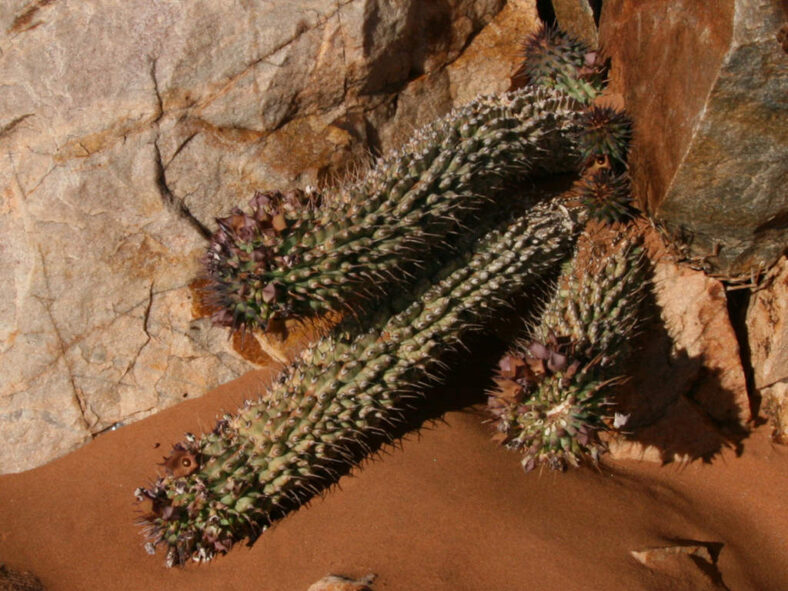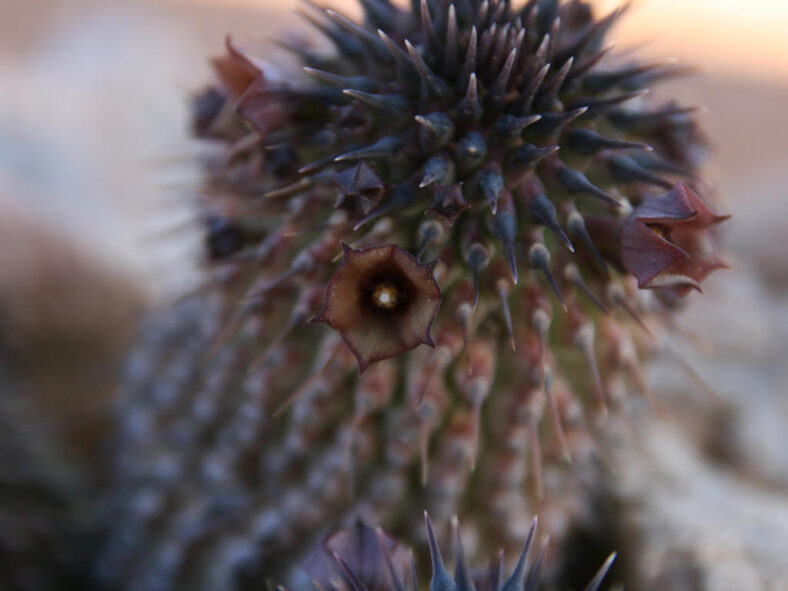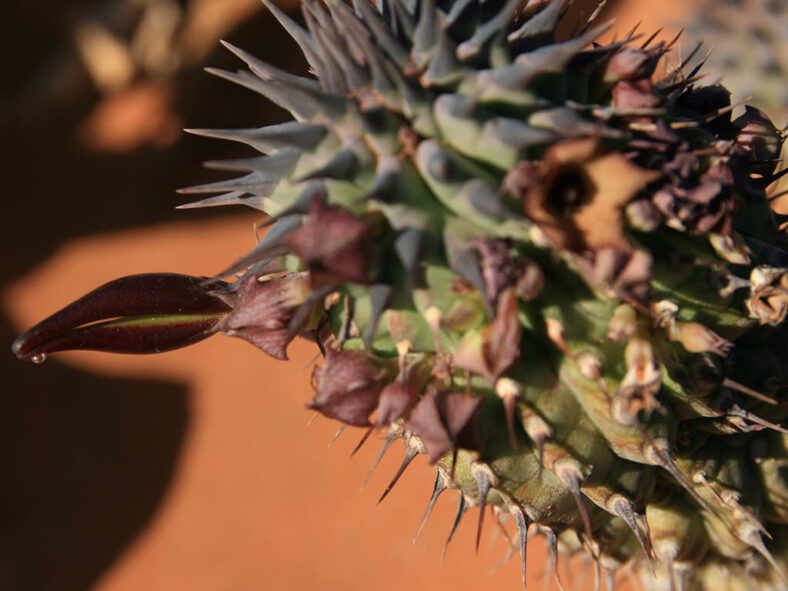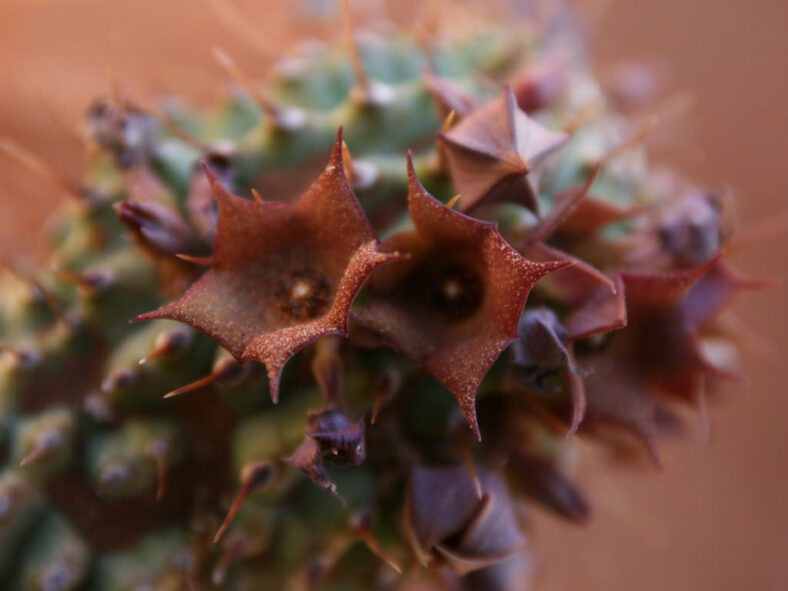Hoodia officinalis is rare in cultivation, and the subspecies Hoodia officinalis subsp. delaetiana is even more uncommon. The two subspecies, Hoodia officinalis subsp. officinalis and Hoodia officinalis subsp. delaetiana, can mainly be distinguished by their native distribution. Additionally, subsp. delaetiana is larger, featuring longer spines and larger flowers.
Scientific Name
Hoodia officinalis subsp. delaetiana (Dinter) Bruyns
Synonym(s)
Ceropegia officinalis subsp. delaetiana, Hoodia delaetiana, Trichocaulon delaetianum
Scientific Classification
Family: Apocynaceae
Subfamily: Asclepiadoideae
Tribe: Ceropegieae
Genus: Hoodia
Etymology
The subspecific epithet "delaetiana" (pronounced "del-ay-tee-AH-nuh") honors Frans (Frantz) de Laet (1866-1928), a Belgian succulent plant expert and horticulturist in Kontich.
Origin
Hoodia officinalis subsp. delaetiana is native to southern Namibia. It is restricted to the Tsau ǁKhaeb (Sperrgebiet) National Park and grows on lower mountain slopes and rocky outcrops.
Description
Hoodia officinalis subsp. delaetiana is a succulent shrub with gray-green to brown-green stems that can either be upright or sprawling. The stems have tubercles joined in the lower half, forming 14 to 23 angles, each tipped with a sharp, brown spine. They can grow up to 16 inches (40 cm) long and 2.8 inches (7 cm) thick, with the spines measuring up to 0.5 inches (1.2 cm) long.
In early spring, Hoodia officinalis subsp. delaetiana produces bell-shaped flowers that can reach a diameter of up to 0.8 inches (2 cm). The corolla is reddish-brown to pale green with brownish veins on the outside, while the inside is red-brown to yellow-brown, covered in small conical papillae tipped with fine bristles. The flower tube is often a much paler yellow. The corona is raised on a very short stipe and varies in color from yellow to dark red-brown.

How to Grow and Care for Hoodia officinalis subsp. delaetiana
Light: Hoodia officinalis subsp. delaetiana prefers full sun but will benefit from light shade during the hottest summer days. Indoors, place the plant near the brightest window of your home because it will stretch if it does not receive enough sunlight. Avoid abruptly moving a plant adapted to lower light levels to full sun to prevent sunburn.
Soil: Use commercial potting soil mix for succulents or prepare your own with 50% to 70% mineral grit, such as coarse sand, pumice, or perlite.
Temperature: The plant thrives in warm outdoor environments with low to moderate humidity. It does not like winter cold and should remain fairly dry and warm during its dormancy. Hoodia officinalis subsp. delaetiana grows best in USDA Plant Hardiness Zones 10a to 11b, with average minimum winter temperatures ranging from 30°F to 50°F (-1.1°C to 10°C).
Watering: It has typical watering needs for a succulent. During the growing season, from spring to fall, water the plant thoroughly and allow the soil to dry between waterings. When it goes dormant in winter, it needs almost no water, about once a month.
Fertilizing: Fertilizing is a good idea to keep the plant healthy and thriving. Feed it with water-soluble fertilizer diluted to half the recommended strength, but only when the plant is actively growing.
Repotting: Repot Hoodia officinalis subsp. delaetiana in spring, just before the growing season. It has shallow roots and does not require too much soil to grow. Always pick a container with drainage holes.
Propagation: The best way to propagate this succulent is by stem cuttings. To ensure good rooting, take cuttings during the growing season. The plant is also easy to start from seeds in spring.
Learn more at How to Grow and Care for Stapeliads.
Toxicity of Hoodia officinalis subsp. delaetiana
Hoodia officinalis subsp. delaetiana is non-toxic and safe to grow around kids and pets.
Links
- Back to genus Hoodia
- Succupedia: Browse succulents by Scientific Name, Common Name, Genus, Family, USDA Hardiness Zone, Origin, or cacti by Genus
Photo Gallery
Click on a photo to see a larger version.


